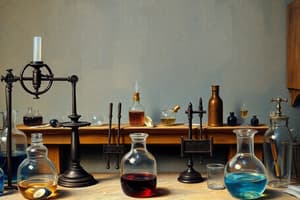Podcast
Questions and Answers
Match the following descriptions with the correct laboratory apparatus:
Match the following descriptions with the correct laboratory apparatus:
Cylindrical glass containers for holding, mixing, and measuring liquids = Test Tubes Instruments used to transfer or measure small volumes of liquids accurately = Pipettes Gas-fired heating devices for laboratory equipment and liquid evaporation = Bunsen Burners Containers with a wide mouth and spout for pouring liquids = Beakers
Match the laboratory apparatus with their primary function:
Match the laboratory apparatus with their primary function:
Test Tubes = Holding, mixing, and measuring liquids Pipettes = Transferring or measuring small volumes of liquids accurately Bunsen Burners = Heating laboratory equipment and evaporation of liquids Beakers = Mixing and heating liquids
Match the laboratory apparatus with their typical usage:
Match the laboratory apparatus with their typical usage:
Test Tubes = Reaction vessels for chemical reactions and diagnostic tests Pipettes = Accurately measuring liquid volumes Bunsen Burners = Heating laboratory equipment and maintaining temperature Beakers = Mixing and heating liquids
Match the laboratory apparatus with their design feature:
Match the laboratory apparatus with their design feature:
Match the laboratory apparatus with their primary usage:
Match the laboratory apparatus with their primary usage:
Match the scientific discipline with its commonly used apparatus:
Match the scientific discipline with its commonly used apparatus:
Match the experiment type with the necessary equipment:
Match the experiment type with the necessary equipment:
Match the safety consideration with the laboratory hazard:
Match the safety consideration with the laboratory hazard:
Match the environmental science task with the required equipment:
Match the environmental science task with the required equipment:
Match the experiment purpose with the corresponding laboratory apparatus:
Match the experiment purpose with the corresponding laboratory apparatus:
Flashcards are hidden until you start studying
Study Notes
Laboratory Apparatus and Equipment: A Focus on Test Tubes, Pipettes, Bunsen Burners, and Beakers
Laboratory apparatus and equipment are essential components of any scientific research or educational setting. In this article, we'll delve into the world of test tubes, pipettes, Bunsen burners, and beakers, exploring their fundamental roles, designs, and uses.
Test Tubes
Test tubes are cylindrical glass containers with a diameter of approximately 1.2 cm and a height of around 15 cm. They are designed for holding, mixing, and measuring liquids, and are typically graduated to display different liquid levels. Test tubes also serve as reaction vessels for chemical reactions, biological experiments, and diagnostic tests.
Pipettes
Pipettes are instruments used to transfer or measure small volumes of liquids accurately. They come in various types, such as manual, electronic, and positive displacement pipettes. Manual pipettes allow for the precise measurement of liquid volumes by creating a vacuum, while electronic pipettes offer a more automated, accurate, and efficient alternative.
Bunsen Burners
Bunsen burners are gas-fired heating devices commonly used for heating laboratory equipment, sterilization, or evaporation of liquids. Fueled by natural gas or propane, Bunsen burners produce a stable flame, which can be controlled by adjusting the airflow. They are also used for heating water baths and maintaining a consistent temperature in scientific experiments.
Beakers
Beakers are conical, cylindrical glass containers designed for measuring and holding liquids. They are graduation-marked, allowing for precise liquid level measurements. Beakers are typically used for simple, large-volume measurements, like mixing chemicals or heating liquids.
Applications
Laboratory apparatus and equipment are fundamental tools in many scientific disciplines. Some applications include:
- Biology: Test tubes, pipettes, and beakers are commonly used in biological experiments, such as cell culturing, DNA extraction, and enzyme assays.
- Chemistry: Test tubes, pipettes, and Bunsen burners are essential for chemical reactions, such as precipitation, titration, and combustion.
- Microbiology: Test tubes, pipettes, and Bunsen burners are used for sterilization and bacterial culturing, as well as for performing biological assays.
- Physics: Beakers, test tubes, and Bunsen burners are used in physical experiments and demonstrations, such as creating gas pressure, heating materials, or measuring temperature.
- Environmental science: Test tubes, pipettes, and Bunsen burners are used to collect and test environmental samples, such as soil, water, and air pollution.
Safety Considerations
Laboratory apparatus and equipment involve potential hazards, such as burns, inhalation of toxic fumes, and chemical spills. To minimize risks, laboratory users should follow safety protocols, such as wearing personal protective equipment, using fume hoods when necessary, and properly disposing of waste materials.
In conclusion, laboratory apparatus and equipment, such as test tubes, pipettes, Bunsen burners, and beakers, are essential components of scientific research and education. They are used in various disciplines and applications, and it's crucial to understand their functions and safety considerations to ensure proper usage.
Studying That Suits You
Use AI to generate personalized quizzes and flashcards to suit your learning preferences.




